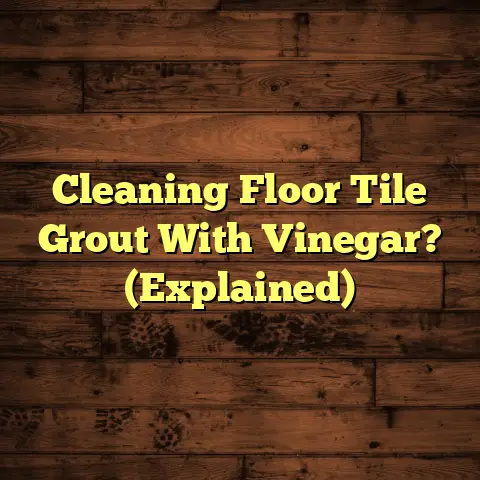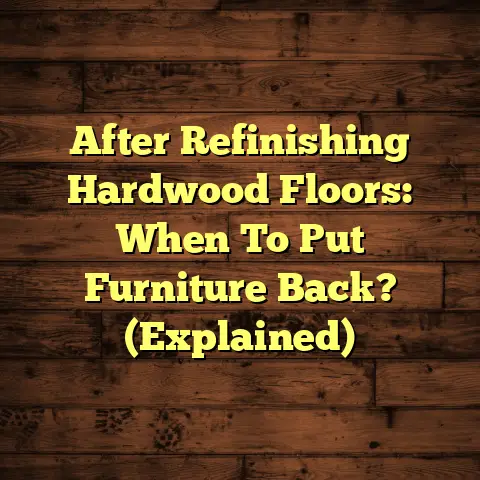Apple Cider Vinegar on Wood? (3 Floor Fails!)
How often do you find yourself searching for natural cleaning solutions that fit seamlessly into your busy lifestyle?
I get it. We’re all looking for that magic bullet – something that’s both effective and kind to our homes (and the planet!).
But sometimes, those seemingly perfect solutions can backfire, especially when it comes to our beautiful wood floors.
As a flooring contractor who’s seen it all, I’m here to tell you the truth about using apple cider vinegar (ACV) on wood.
Spoiler alert: it’s not always the best idea.
The Allure of Natural Cleaning Solutions
Let’s face it, we’re living in a world that’s increasingly conscious of the products we use in our homes.
The rise of “natural” cleaning solutions is a testament to this shift.
And apple cider vinegar? It’s become a rockstar in the natural cleaning world!
But what exactly is apple cider vinegar?
It’s basically fermented apple juice.
The fermentation process creates acetic acid, which gives ACV its cleaning power.
People love it because it’s relatively inexpensive, readily available, and boasts antibacterial properties.
It’s also pretty good at cutting through grease and grime.
Many homeowners turn to ACV as a non-toxic alternative to harsh chemical cleaners.
It seems like a win-win, right?
Well, not always.
Understanding Wood Flooring
Before we dive into the potential disasters, let’s talk about wood flooring.
It’s not all created equal.
You’ve got hardwood (like oak, maple, and hickory), engineered wood, and even laminate that looks like wood.
Each type has its own unique properties and vulnerabilities.
Hardwood, for example, is solid wood through and through.
It’s beautiful and durable, but also susceptible to moisture damage.
Engineered wood has a thin layer of hardwood veneer over a plywood core.
This makes it more stable than solid hardwood, but still not completely impervious to water.
Laminate flooring is a different beast altogether.
It’s basically a photograph of wood glued to a composite core.
While it’s often water-resistant, it’s not waterproof, and the seams can still let moisture in.
No matter what type of wood flooring you have, maintenance is key.
Regular cleaning and care can prolong its life, enhance its appearance, and protect your investment.
Think of your wood floors like a fine piece of furniture – they need to be treated with respect!
One of the biggest threats to wood flooring is moisture.
Wood expands and contracts with changes in humidity, which can lead to warping, cracking, and other problems.
Certain chemicals can also damage the finish on wood floors, leading to discoloration and dullness.
This is where apple cider vinegar comes into the picture… and not always in a good way.
The Risks of Using Apple Cider Vinegar on Wood Floors
Okay, let’s get down to the nitty-gritty.
While ACV might seem like a harmless, natural cleaner, it can actually wreak havoc on your wood floors if you’re not careful.
I’ve seen firsthand the damage it can cause, and trust me, it’s not pretty.
Here are three specific “floor fails” that can occur when ACV is improperly used on wood surfaces:
Fail #1: Damage from Over-Saturation
This is probably the most common ACV-related flooring disaster I see.
The problem?
Excessive moisture.
When you use too much ACV solution on your wood floors, the liquid can seep into the seams between the planks.
Over time, this can cause the wood to warp, buckle, and even rot.
Think of it like leaving a wet towel on a wooden table – eventually, the wood will start to swell and distort.
The same thing happens with your floors, but on a much larger scale.
I remember one client who was convinced that ACV was the only way to clean her hardwood floors.
She used a generous amount of ACV solution every week, thinking she was doing a great job.
But after a few months, she started noticing that her floors were starting to look uneven.
Upon closer inspection, we discovered that the seams between the planks were swollen and raised.
The floors had to be completely replaced, costing her thousands of dollars.
According to the National Wood Flooring Association (NWFA), proper moisture control is crucial for maintaining the integrity of wood floors.
They recommend keeping the humidity level in your home between 30% and 50% to prevent moisture-related problems.
Using too much ACV solution can definitely throw those levels out of whack!
Fail #2: Discoloration and Staining
Another potential problem with ACV is discoloration and staining.
The acidity of apple cider vinegar (it typically has a pH between 2 and 3) can react negatively with certain finishes on wood floors.
This is especially true for older finishes that may be worn or damaged.
The acid can eat away at the finish, leaving behind dull spots or even permanent stains.
I once had a customer who used an ACV solution to clean a spill on her newly refinished hardwood floors.
She wiped it up immediately, but a few days later, she noticed a light patch where the spill had been.
The ACV had reacted with the finish, causing it to fade.
Unfortunately, the only way to fix the problem was to refinish the entire floor again.
Not fun!
Even if you don’t notice immediate discoloration, repeated use of ACV can gradually dull the finish on your wood floors over time.
This is because the acid slowly breaks down the protective coating, leaving the wood exposed and vulnerable.
Fail #3: Residue Buildup and Dullness
Ironically, one of the reasons people use ACV is to make their floors look cleaner and shinier.
But in some cases, it can actually have the opposite effect.
Using ACV can sometimes lead to a buildup of residue on wood floors, making them look dull and unattractive.
This is especially true if you’re not using the right dilution ratio or if you’re not rinsing the floors properly after cleaning.
The residue can attract dirt and grime, making your floors look even worse than before.
I’ve seen this happen with laminate floors as well.
A friend of mine thought she was getting a great deal by using ACV to clean her laminate floors.
But after a few weeks, she noticed that her floors looked cloudy and streaky.
No matter how much she scrubbed, she couldn’t get rid of the dull film.
It turned out that the ACV was leaving behind a residue that was attracting dirt and making her floors look dingy.
She eventually had to switch to a laminate-specific cleaner to get her floors looking their best again.
Alternative Cleaning Solutions for Wood Floors
So, if ACV is a no-go, what should you use to clean your wood floors?
Luckily, there are plenty of safer alternatives that are specifically designed for wood care.
Here are a few options:
- Wood floor cleaners: These are specially formulated to clean wood floors without damaging the finish. Look for pH-neutral cleaners that are recommended by flooring manufacturers.
- Mild soap and water: A solution of mild dish soap and water can be effective for cleaning wood floors, but be sure to use a very small amount of soap and rinse thoroughly.
- Steam mops: Steam mops can be a good option for cleaning sealed hardwood floors, but be sure to use a low steam setting and avoid over-wetting the floors.
- Microfiber mops: Microfiber mops are great for picking up dirt and dust without scratching the floor. Use them dry or with a small amount of wood floor cleaner.
Remember, it’s always a good idea to test any cleaning solution in an inconspicuous area before using it on your entire floor.
And always follow the manufacturer’s instructions for cleaning your specific type of flooring.
Conclusion and Reflection
So, what’s the takeaway here?
While apple cider vinegar might seem like a natural and effective cleaning solution, it’s not always the best choice for wood floors.
The acidity of ACV can damage the finish, cause discoloration, and even lead to long-term moisture problems.
It’s so important to be informed about the products you use in your home.
Understanding your flooring materials and the implications of using acidic solutions like apple cider vinegar can save you a lot of headaches (and money!) in the long run.
I always advise homeowners to err on the side of caution when it comes to cleaning their wood floors.
Using a product specifically designed for wood care is always the safest bet.
Ultimately, the best way to keep your wood floors looking their best is to prevent messes in the first place.
Use doormats to trap dirt and debris, clean up spills immediately, and avoid wearing shoes indoors.
With a little bit of care and attention, your wood floors can last for years to come.
What are your experiences with wood floor cleaning?
Have you ever tried using ACV on your floors?
I’d love to hear your stories and any lessons you’ve learned!
Share your thoughts in the comments below. Let’s learn from each other and keep our floors looking beautiful.





